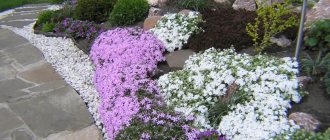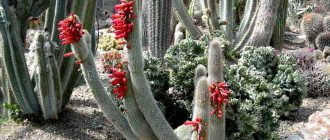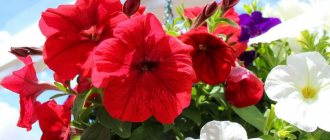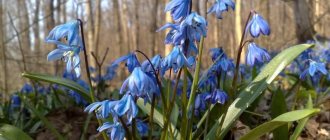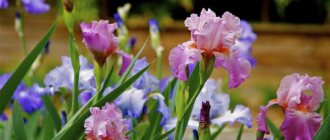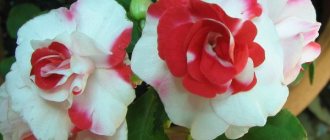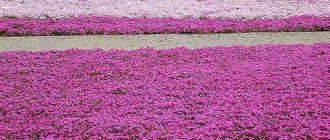Annuals can transform any vegetable garden into a colorful, picturesque garden. However, not all gardeners have the luxury of growing annual flowers from seedlings at home each year. You can solve the problem very elegantly: sow seeds of annual flowers, which reproduce by self-seeding, as seedlings or directly in open ground. Thanks to such crops, you can “plant and forget” about them, enjoying their flowering every year.
Self-seeding annuals: eschscholzia (California poppy)
A low-growing, compact plant 25-30 centimeters in height, which forms branched bushes covered with large flowers of rich colors (orange, yellow, hot pink, etc.). In cloudy weather, the flowers are closed, but the plant does not lose its attractiveness thanks to the openwork carved silvery foliage.
Eschscholzia (California poppy).
In appearance, Eschscholzia inflorescences resemble a miniature poppy with satin petals, but there are also varieties with double inflorescences, as well as with corrugated petals, reminiscent of the chiffon skirts of fashionistas.
Eschscholzia produces a large number of seed pods, which it is advisable to remove to prolong the flowering period, however, if you plan to self-sow, then some of the heads must be left. Eschscholzia is light-loving and drought-tolerant, and will grow well with minimal watering without requiring much care.
What are self-sown flowers?
Among annual plants there is a group of flowers that are capable of reproducing themselves. They, like all summer birds, complete the entire development cycle in one season and the seeds ripen in the fall. They spill out onto the ground and with the help of the wind, animals, birds, etc. spread throughout the area. Self-sown seeds overwinter quietly, and in the spring they come to life and produce numerous seedlings. So one flower can leave behind a large number of new plants. Thanks to this, there is no need to sow and plant seedlings every spring.
Compared to their counterparts sown in spring, seedlings of self-sowing flowers are more resilient, grow better and begin to bloom earlier.
Some biennial and perennial plants also have the ability to reproduce by self-sowing.
Self-seeding annuals: alyssum
Alyssum creates a wonderful low mat 15-20 centimeters high, which is ideal for planting on the sides of paths, in the foreground of flower beds, as well as for flowerpots and hanging baskets.
Alyssum.
Most varieties have a sweet, honey aroma. But some modern hybrids are odorless, which allows them to be planted by people suffering from intolerance to flower aromas.
Most varieties of alyssum have small white inflorescences or petals of a lilac color, from dark purple to soft lavender. “Esther Bonnet Peach” , which is distinguished by unusual pink flowers with a peach tint, is very interesting
To make alyssum look impressive, it is better to plant it in large clumps. The plant is characterized by very abundant flowering, but alyssum blooms in waves. And after the first wave of flowers has faded, all the inflorescences must be cut off, then after a while flowering will resume with renewed vigor.
To obtain self-seeding, only part of the faded flowers of the first wave is cut off. Also, if the second wave of flowering began not too late (with the seedling method of cultivation), the inflorescences can be cut off completely, and after the second wave of flowering, all the seed pods can be left to ripen on the plant.
Annuals for self-sowing: growing tips
Prepare appropriate conditions for annuals to self-sow. Find them a place where they can reproduce themselves year after year. Make sure there is no standing water in the area in the spring. For plants that require sunlight, it is advisable to find a suitable clearing.
From time to time you will find your annuals in unexpected places where you didn't plan. Insects, animals and wind simply perform their functions well. It's not a problem. You can always transplant a fugitive to his relatives.
Self-sowing annuals are not always a good choice unless you are sure you will not want to change or move the flower garden to next year. And for mixborderers, annuals are a real find. The varieties will be mixed with neighboring ones and every year the flower garden will look different without the intervention of others.
One of the advantages of annuals for self-sowing is the ability to prolong flowering by cutting off those that have already bloomed. However, it can also cause harm. If you continue to cut off the seed heads, there may be very few left. Or they won’t have enough time to ripen and sow.
To avoid this situation, make it a rule to leave annuals to ripen from the beginning, or maximum from the middle, of August. If the seed heads are completely dry, then everything is in order, as they ripen and prepare for self-sowing.
There is no need to remove old leaves in the fall. Leave the tops until spring, when the snow melts. Water generously the places where last year's flower bed was located. Don't rely on rain, even if it's heavy. Since the seeds simply “fell” onto the ground, no one buried them, and they remained on the surface. In such a situation, they can very easily dry out, which will lead to poor-quality sowing.
Follow these simple rules and new shoots will not keep you waiting long.
Self-seeding annuals: Iberis
In culture, there are two types of Iberis - annual and perennial. The latter has white flowers and low clumps; the main area of application of this flower is alpine slides and retaining walls. But the annual Iberis is used very widely, and first of all, it is a delicate flower bed flower, unpretentious and easy to care for.
Iberis.
You can recognize this Iberis by its umbrella-shaped inflorescences of lilac and pinkish color. The annual Iberis blooms more abundantly than the white perennial species.
This plant grows best in cool weather. In this regard, seeds need to be sown in open ground as early as possible so that they can bloom and show themselves in all their glory before the onset of the summer heat.
Once you have planted this flower in the garden, you don’t have to think about its further reproduction, because the self-sowing of Iberis is very abundant, and in the spring you can give seedlings to all your neighbors.
At the same time, it is difficult to call Iberis a “weed”; its low and not too branchy bushes will not take up too much space in the garden, even if they grew in an unnecessary place, they can be easily replanted later.
Thanks to its endurance, this delicate flower will independently decorate those corners of the garden where it is difficult to grow anything.
Fragrant tobacco
Fragrant tobacco with white, red, yellow, pink or crimson star flowers is very popular among gardeners. Its amazing aroma attracts bees to the site. The most fragrant are the flowers with pale colors.
As a rule, flowers open in the evening, at sunset. At this time they begin to smell even stronger. Fragrant tobacco blooms from mid-summer until autumn.
The ornamental plant is not picky about the soil, but if the soil is poor, then in the fall it needs to be dug up and humus or compost added. The plant does not like direct sunlight and strong wind.
When planting in the ground, the distance between the bushes should be 20-30 cm. This is a heat-loving plant, so it is planted only in the complete absence of frost at night.
In the middle zone, fragrant tobacco can reproduce by self-sowing, but in the absence of snow in winter and frosty weather in spring, there may be no seedlings. Therefore, most often for the winter, fragrant tobacco is transplanted into pots and put away indoors. In spring, the bushes are replanted into open ground.
Self-seeding annuals: cornflower
Among garden flowers it is not easy to find one that would surpass the cornflower, having petals of a purer and deeper blue color than its own. And it’s not for nothing that there is a shade of blue called cornflower blue.
Cornflower.
In the wild, cornflower can most often be found in rye fields, but lately you have rarely seen it in gardens. To some gardeners, this plant seems rustic. Nevertheless, cornflower has a special charm, and in modern varieties you can find inflorescences of very different colors (pink, white, purple), and some varieties even have dark burgundy, almost black flowers.
In addition, low-growing compact varieties that do not exceed 25 centimeters have appeared on sale, as opposed to the common tall varieties that reach 60 centimeters.
Cornflowers are very easy to grow; they can be sown in the garden directly into the ground and only once, and they will reproduce on their own. Cornflowers bloom from June to September, but they perform best in the absence of intense heat (in early summer and early autumn).
Self-seeding annuals: purslane
Purslane is an ideal annual ground cover for dry, sunny locations, where it can show up in all its cheerful glory with minimal care. Its colorful flowers look like bright butterflies sitting down to rest in a clearing.
Purslane.
Unfortunately, in cloudy weather and towards evening the inflorescences close their petals and look like folded umbrellas. But the attractiveness of the plants does not disappear because of this; purslane is a succulent plant with juicy thick leaves, thanks to which people are sometimes called “fat weed.”
This emerald carpet, woven from thickened leaves, looks very original even in the absence of flowers. When sowing for the first time, it is better to use the seedling growing method and sow the seeds indoors. Subsequently, the clearing of multi-colored purslane will be renewed without your direct participation.
However, it is important to keep in mind that purslane is very thermophilic and can emerge very late (in some years even only at the beginning of June). However, thanks to the rapid development, the plants manage to bloom by mid-summer and delight with flowers until autumn.
Iberis
You may have come across a perennial relative of Iberis on alpine hills or as a retaining wall. It has white inflorescences and small beds. But the annual is more widely known. It does not require special care.
Iberis is a friendly club plant of delicate lilac or pink color. The umbrella-shaped inflorescence of rich color will appeal to many. And the annual blooms much more profusely than its perennial version. Annual Iberis prefers cool weather, so for better flowering it is worth sowing early in open ground, taking into account that the peak of flowering should pass before the onset of heat.
In addition to minimal care for the flower, you also do not have to waste time on its further reproduction. Self-sowing occurs with a large number of seeds. And in the spring you will be able to share this miracle plant with your neighbors without making any effort.
Also, bushes can be easily replanted if new ascents take the wrong place. The bushes are small and not very branched. Separately, it is worth noting the exceptional independence and endurance of this plant. So don't be afraid to place it where nothing else grows.
Self-sowing annuals: calendula (marigolds)
An annual plant with golden and bright orange flowers and light green sticky foliage. Cheerful calendula is very unpretentious and is characterized by long, continuous flowering until late autumn.
Calendula "Sunset".
Young seedlings, as well as adult plants, can withstand even light frost. Calendula is credited with the ability to protect vegetable plants from pests and diseases, so this flower is popular for planting in the garden next to vegetables.
But the medicinal properties of the plant have been scientifically confirmed, and dried heads can be found for sale in any pharmacy. But many people prefer to procure raw materials themselves, collecting inflorescences in their own flower beds.
Calendula is also an edible flower and its bright petals can be used to decorate salads and desserts. Modern varieties of calendula have very large, densely double flowers, reminiscent of chrysanthemum inflorescences. The color of the inflorescences, like those of natural forms, is most often yellow and orange. But at the same time, you can find very original shades of these colors, for example, the “Sunset” has creamy apricot flowers, and the “Lemon Jam” has pale yellow flowers.
Calendula
Calendula marigold is an annual with sun-colored flowers and sticky stems and leaves. Calendula blooms throughout the summer until mid-autumn without interruption. Seedlings are not afraid of cold, just like an adult plant. It has gained great popularity among gardeners for its properties. The plant is able to repel pests and some diseases from vegetables and herbs. For this reason, calendula can be found on the sides of beds.
Calendula will also serve in another important matter. Science has long known about its medicinal properties. Dried inflorescences are sold in pharmacies, but it is much more useful to make the preparations yourself.
In addition, calendula marigolds can serve as a decoration for salads and desserts - it is an edible plant. Now there are varieties that have large, densely double inflorescences that resemble chrysanthemums in appearance. Among the possible shades there are soft apricot and bright yellow.
Self-seeding annuals: annual delphinium
This annual delphinium flower is a cultivated form of delphinium arvensis, also known as larkspur. This species is a good replacement for the perennial delphinium. Varietal larkspur has large double flowers, very similar to the inflorescences of perennial delphinium, only with more pointed tips of the petals.
Delphinium annual.
The color can be very different: purple, pink, white, lilac, etc. In addition, the annual delphinium has very beautiful carved, deeply dissected foliage, similar to dill leaves. Depending on the variety, this flower can form low compact bushes 25 cm in height or produce tall, strong stems more than one meter high.
Showy larkspur candles are good in flowerbeds and mixed borders, and tall varieties can be planted as an annual hedge. In addition, annual delphinium is used for bouquets, as it lasts a long time in a vase. This cold-resistant plant can be sown before winter, then the seedlings will bloom from June to August. When sown in early spring, flowering will begin later - from July to September.
Self-seeding annuals: cosmos (Cosmos)
One of the most unpretentious summer flowers that can be found in almost every front garden, since plant care is minimal, and the bright daisy inflorescences are always pleasing to the eye.
Kosmeya (Cosmos).
The variety of cosmos colors available increases every year. On sale you can find delicate pastel shades or bright, cheerful colors. There are often double varieties, whose flowers, depending on the variety, can be similar to asters or scabioses. Also interesting is the sulfur-yellow cosmos, which is distinguished by very unusual colors for cosmos: bright yellow and orange.
Large cosmos inflorescences are attractive not only to humans; cute “daisies” are loved by bees and a wonderful “airfield” for butterflies. Many gardeners may be put off by the tall growth of this annual, but today you can also find compact hybrid varieties. Cosmea is a prolific flowering plant that will bloom all summer. The first sowing can be done directly into the ground in May.
Cosmea
Cosmea can be found in many front gardens. And for a reason. This is a very unpretentious summer plant. The flowers resemble daisies, but the color of the petals varies from white to deep burgundy.
Moreover, every year the variety of varieties of this plant only increases. At the moment, even terry shades have been added to the palette. And the diversity of flowering has expanded to include varieties similar to asters and scabioses.
Specimens that are unusual for cosmos stand out from the general set of shades. Such as bright yellow and orange. However, no matter what color of seedling you choose, it will undoubtedly attract a large number of butterflies and bees.
Typically, cosmos is a fairly tall plant. But there are also more compact options. Flowering occurs very abundantly and lasts throughout the summer. Sowing can be done in open ground in mid-May.
Self-seeding annuals: rudbeckia
This flower is a popular garden perennial, known even to novice gardeners. However, rudbeckia also has annual forms that are very similar in appearance, but do not form an overwintering rhizome.
Rudbeckia.
Often, annual varieties bloom more profusely than their perennial relatives, their flowers are larger, and the palette of colors is richer. For example, among annual rudbeckias you can even find red-brown flowers, for example, the Cherry Brandy .
Due to the fact that this flower self-sows well, you don’t have to worry about reproducing it next season. Once sown, annual rudbeckia will appear annually in your garden on its own, and in this regard it is in no way inferior to perennials, being the same unpretentious sunny flower.
Self-seeding annuals: coreopsis
The annual form of coreopsis has small variegated flowers, which are distinguished by a very bright two-color color. The chamomile-shaped inflorescences of coreopsis most often have an expressive dark burgundy center, and the tips of the petals are colored white, yellow and pink. This combination looks very fun and playful, and such plants will always attract the eye.
Coreopsis.
The inflorescences of annual coreopsis are much smaller than those of the most common perennial variety of coreopsis lanceolata, but this form blooms much longer and more abundantly. In order for the plant to self-sow, from the second half of summer it is necessary to stop cutting off the faded inflorescences.
In winter, birds can feast on the heads with coreopsis seeds, but most of the seeds will be preserved and will sprout next spring.
Coreopis
In appearance, the small flowers resemble chamomile. But at the same time, the petals have a variegated two-color color. Closer to the center, the petals are most often dark burgundy. And closer to the tips they acquire a yellow, pink or white tint. Coreopis will enliven and decorate any garden and attract large numbers of butterflies.
The flowers are smaller than those of the perennial version. But it blooms much longer and more colorfully. During the summer period, faded flowers should be cut off. Except for the latter, if you want to observe them in your garden next year. It is very important to take into account that during winter birds will want to eat the heads with seeds. Therefore, it is important to correctly calculate the number of inflorescences set aside.
Self-seeding annuals: nigella
A relative of garden nigella, nigella orientalis is used as a popular spice and valuable medicinal raw material in the countries of the East, where it is known as “black cumin.” Another type of this plant is grown in flower beds - Nigella Damascus .
Nigella Damascus.
This flower is distinguished by very beautiful double star-shaped flowers of a pale blue color with an original center in the form of hooks. In the mixture of colors, in addition to blue, pink, violet, purple and two-color flowers are also often found, which stand out against the backdrop of delicate, feathery foliage.
The only drawback of nigella is its short flowering period, and in order to have a flowering carpet of nigella all summer long, you have to sow the seeds at intervals of about one month.
Nigella is unpretentious in care, this plant is cold-resistant, tolerates heat and slight drought. Original seed pods can be used as an interesting addition to winter dry bouquets.
Ten best self-seeding flowers
We offer a brief overview of the best representatives of ornamental flowering plants that actively reproduce by self-seeding.
- Beautiful petunia . This is one of the most beautiful plants, which pleases with its bright and very beautiful flowering, which is represented by “gramophones” of rich colors. Petunia is a unique plant, since it has not only many shades, but also different principles of growth - ordinary and ampelous representatives, with different colors and structure, where double representatives occupy their due place. It is noteworthy, but be prepared for the fact that only petunias of the simplest specimens can expand their plantings without outside help; this should not be expected from hybrids. Remember, the juxtaposition of different shades of petunias is not only a very beautiful tandem, but also a unique opportunity to feel like a breeder, since as a result of pollination, you will definitely get something very beautiful.
- Marigold or calendula . Calendula can easily be considered a popular self-sowing plant, which actively spreads and fills the orange area with rich shades. The plant is of moderate height, but if you periodically pinch it, you can achieve scale, bright colors and an acceptable plant height of up to 70 centimeters. Marigold seeds are scattered throughout the area without any problems, overwinter successfully and germinate safely in the spring. Minimum hassle. It is noteworthy that this plant is capable of providing not only decorative value, but also bactericidal value, therefore it is actively used in traditional medicine in the form of tinctures.
- Antirinum or Snapdragon . This plant received its majestic name for a reason, since the original majestic shape and location are a feature of the plant. A bright palette of shades is the advantage of a plant that has been fragrant with bright colors since June. You can easily meet purple and pink, yellow and orange, as well as blue representatives. The beauty of the plants delights those around them until the first frost. The average performance of the plant is moderate, slightly exceeding the mark of half a meter, although there are also representatives that can easily reach a meter. Remember, this ornamental plant can be safely used for cutting.
- Eschszolzia . A bright and very beautiful unpretentious plant will become an invariable attribute of every flower bed. Minimum effort – maximum decorative value. Bright shades of yellow and orange dominate this plant, although more pastel options, all shades of white, are also acceptable. Thanks to external data, almost everyone has seen Eschsolzia in person. In addition to external features, the plant has a very favorable list of requirements - the soil is sandy, not fertile, places where there is little that grows are very suitable for such a modest plant. The parameters are moderate, maximum 40 cm, although often the figures are much lower. Self-seeding occurs en masse and abundantly.
- Lavatera or khatma. A large-scale plant with large inflorescences that are very reminiscent of mallow is a lavatera, or as it is popularly considered a wild rose. The inflorescences can have different shades, but the shape of a funnel with a small middle is a recognizable feature and feature. Many people associate it with mallow. The plant is quite tall, since the 120 cm mark is not the limit. Due to such a scale, the location mainly takes place in the background, since partners and neighbors on the site can be very different, but the decorativeness and value are unchanged. On large shrubs large inflorescences are formed, where the diameter can vary and can easily reach up to 10 centimeters. The strength of the plant is considered to be the ability to withstand any weather changes; they adapt well to any area and delight with bright colors, from July until frost. If the plant is regularly watered and fertilized at least once, the inflorescences will be larger, brighter and more saturated. The location of the roots is on the surface itself, so when loosening you should not go too deep, as you can significantly damage the root system.
- Lobularia or alyssum . These are absolutely two different plants, but due to their close relationship, few people are able to distinguish these two flowers, so small inflorescences collected in bouquets are figuratively called by the same name - alyssum or lobularia. The plant is not tall, rather a ground cover, with a height of several tens of centimeters up to 40. Feel free to use them as an hanging plant, as they are able to hang down. Flowering is a beautiful culmination, accompanied by different shades. In addition to its aesthetic value, this plant has a distinct honey aroma, which helps elevate the plant’s status to a honey plant. The plant forms a large shrub that is abundantly located on the territory. You can significantly prolong the fragrance of lobularia in a simple way - cut off all faded inflorescences, thereby provoking the appearance of new ones - a technology for the appearance of many inflorescences over a long period.
- Forget-me-not or gourd . Compact, but very beautiful inflorescences of forget-me-nots are unlikely to leave anyone indifferent. There is a certain classic that this plant blooms with a beautiful blue hue, although in fact you can find white and pink representatives. Different weather conditions and temperature changes are not significant for the development of the plant. The location is not so important, since the soil can be any, there are no clear requirements for the composition. The compactness of the plant is a prerogative, because at a height of only 30 cm a full-fledged and very beautiful ornamental flowering plant is formed.
- Cornflowers . Cornflower is an unusual plant that surprises not only with the beauty of its inflorescences, but also with its subtle, captivating aroma - a mixture of mint and cloves, as well as the dominance of lemon - this tandem forms the distinct aroma of cornflower. The color scheme of the inflorescences themselves is different, ranging from lighter shades of blue and pink to rich tones of blue, burgundy and red. Practical use in medicine, cosmetology and floristry will help increase the value of this self-seeding flower.
- Cosmea . Many people mistakenly think that these are daisies, although the color of the petals is very different - all shades of pink, lilac, purple go well with the yellow center. The plant is large-scale, since the diameter of each inflorescence can be more compact in size, or reach 12 cm. Thanks to the original colors, many prefer this particular representative rather than chamomile in their flower garden. The plant grows in a bush, which is considered spreading and branched. It does not require special planting or care conditions, although a sunny area will be favorably received by the plant. Flowering begins with the beginning of summer and ends with the first frost.
- Morning glory . This is a very beautiful and practical representative of hanging plants, which is a member of the Convolvulaceae family. The parameters of the plant are impressive, since the 4-meter mark is not the limit. It is advisable to plant only near fences, structures or special fences. Thanks to its funnel-shaped flowering and mass weaving, impea can significantly transform any area. The only wish is an open area with direct sunlight. The thing is that only in the sun can you contemplate the true beauty of the plant, because the petals open to their fullest. Flowering begins in July and lasts until the weather gets colder. Self-seeding occurs quickly and without problems, and the plant successfully reappears in the spring.
There is no need to worry about plants, their planting and growing season, if there are a number of flowers that successfully sow on their own and annually give those around them magnificent blooms.
Self-sowing annuals: edged spurge
This annual flower is known to many people under the popular name “bride”. And really, what else can you compare these lush snow-white bushes with if not with a girl in a wedding dress?
Euphorbia bordered.
From a distance, it may seem that the spurge plant has very large flowers, consisting of many white-green petals. However, this is not quite true. Like most euphorbias, the “bride” inflorescences themselves are very small and inconspicuous, and the leaves bordering them are of decorative value. In the case of milkweed, they are attractive with a wide, bright white border.
For this type of milkweed, winter sowing or sowing seeds in the ground is practiced in early May; flowering then begins in July and continues until frost. “Bride” is unpretentious and hardy; in the garden it is better to choose sunny places without stagnant water.
Snapdragon
Snapdragon, or Antirrinum, pleases gardeners with a wide variety of flower colors. It can decorate flower beds, lawns, borders, and terraces. Its flowering continues until frost in the fall.
The frost-resistant snapdragon tolerates wintering well in open ground. To do this, in the fall, the antirrinum bushes need to be trimmed very short - the height of the stems should reach 5-8 cm. After this, you need to mulch the area with dried leaves or sawdust mixed with peat.
- Author: iarriba
Rate this article:
- 5
- 4
- 3
- 2
- 1
(6 votes, average: 4.7 out of 5)
Share with your friends!
Self-seeding annuals: morning glory tricolor
Plants that self-sow also exist among ornamental annual vines. In particular, morning glory tricolor , more commonly known as “bindweed” or “gramophones,” reproduces itself very easily.
Morning glory tricolor.
There are a large number of varieties of this type of morning glory of various colors, but they do not reproduce on their own as readily as the original form, which has recognizable dark purple funnel-shaped flowers.
Unusual types of morning glory: name and description of flowers (read more)
Of course, this “folk” bindweed may seem banal to some, but busy flower growers often benefit from having an independent vine that will cover, for example, a veranda every year. After all, “bindweed” in a short time forms very long, well-leafed stems with large leaf blades and perfectly decorates any vertical surface.
Unlike other types of morning glory, morning glory tricolor can be sown directly into the ground, as its development is very fast.
Aster
A common and beloved flower by all. There are so many different shapes and colors available that they will satisfy every taste. Asters can be sown directly into the ground under a film or grown as seedlings.
The plant is unpretentious and cold-resistant, but still grows better in the sun and in fertilized soil. Moderate watering and loosening is all that this flower requires.
How to ensure self-seeding of annuals
For self-seeding annuals, it is preferable to initially select a personal “clearing” where they will grow in a small group, independently reproducing from seeds from year to year.
When choosing a place for sowing such annuals, it is important to choose one where there is no standing water in the spring. Also, most of these flowers require that the space be well lit by the sun during the day.
Of course, insects or wind often facilitate the transfer of seeds, and next season the plant may appear in the most unexpected place, but you can always replant it in the company of its fellows.
Due to their tendency to migrate, in classic flower beds, independent “sprouting” of such annuals is not always appropriate, but for natural mixborders, self-sowing annuals are a real gift, because it helps to change the appearance of the flower garden without the participation of the grower and create new combinations with neighboring perennials every year.
When growing self-seeding annual flowers, it is very important to give the flowers enough time to allow the seeds to fully mature and sow. Therefore, if you have been removing faded heads all summer to prolong flowering, you must stop this procedure no later than mid-August. The seeds need to ripen, and this usually means the seed heads are completely dry.
In the fall, after flowering, the tops of annuals must be left in the place where they grew. Last year's stems are removed only in the spring, as soon as the snow melts. Even if it rains periodically in spring, it is better to regularly water the place where the clump of plants was located.
This is due to the fact that the seeds lying on the surface of the soil dry out very quickly, and this is the reason why flowers do not self-sow as expected. If you regularly maintain humidity in such a “spreading” bed, then the seedlings will not take long to appear, forming a new clearing for flowering in the coming season.
List of flowers that reproduce by self-sowing
Of course, most flowers are annuals, but there are a few biennials and perennials.
Annuals
The most popular and relatively easy to propagate by self-seeding flower crops are:
- Ageratum;
- Amaranth;
- Pansies (Viola);
Especially Viola Horned .
- Alyssum (lobularia) - most often rock or sea;
Advice! If you want to prolong the flowering of alyssum, then after the first wave of flowering you need to shorten its shoots, leaving only short stumps. After new shoots grow, it will bloom even more (“caps”) until frost.
- Aster virginiana or New Belgian (or they also say “September”);
- Marigolds (Chernobrivtsy, Tagetes);
- Cornflowers;
- Delphinium (annual);
- Fragrant tobacco (only in warm regions);
- Iberis;
- Morning glory;
- Calendula (marigold);
- Coreopsis;
- Cosmea;
The most unpretentious self-seeding flower.
- Kochia (summer cypress);
- Lavatera;
- Snapdragon (antirrhinum);
- Lupine;
- Samosa poppy;
- Mallow (Rosa rose);
- Daisies;
- Mattiola (Night violet);
- Euphorbia bordered;
- Nasturtium;
- Nigella Damascus;
- Purslane:
- ordinary,
-terry,
and garden (vegetable);
- Rudbeckia;
- Salvia horminum;
- Celosia;
- Chrysanthemum (annual);
- Eschszolzia;
Eschscholzia comes in not only orange, but also other colors.
- Evening primrose (Oslinnik, Night candle);
By the way! Petunia and lobelia can also self-sow, but they will not bloom very effectively (the flowers will be simple, there will definitely not be double flowers).
Biennials
Important! Biennial flowers must be sown in the summer (June-July) so that their above-ground part (rosette of leaves) has time to grow, overwinter, and then they will bloom next year. If you sow them before winter, then the next year there will be no flowering - only in the second year.
- Turkish cloves;
- Forget-me-not;
- Bellflower (the same peach leaf);
- Digitalis.
Perennial
- Primrose;
- Aquilegia (Catchment);
- Curly fighter (Aconite):
- Gaillardia (Garden Chamomile);
- Dicentra;
Oxalis (Oxalis, Hare Cabbage, Cuckoo Clover);
- Blue flax (perennial);
- Lychnis;
- Nivyanik;
- Liverwort;
- Pyrethrum maiden (Tansy maiden);
- Dyeing navel (Antemis):
- Scabious;
- Physalis ornamental ( not edible );
- Echinacea.
Bulbous flowers (small-bulbous)
Small-bulbous plants that themselves reproduce by seeds (they bloom only for 2-3 years):
- Scilla (Scylla);
- Poultry farmer;
- Pushkinia;
- Chionodoxa;
- Erantis (Zimovnik).
Small-bulbed flowers that reproduce themselves not by seeds, but by daughter bulbs:
- Galanthus (snowdrops);
- Crocuses;
- Muscari;
But tulips and daffodils do not start walking around the garden on their own: mice lose them or forget where they hid them.
Well, now you know which flowers you need to sow once so that they delight you with their blooms year after year. Have fun creating a weekend garden (low maintenance garden)!
